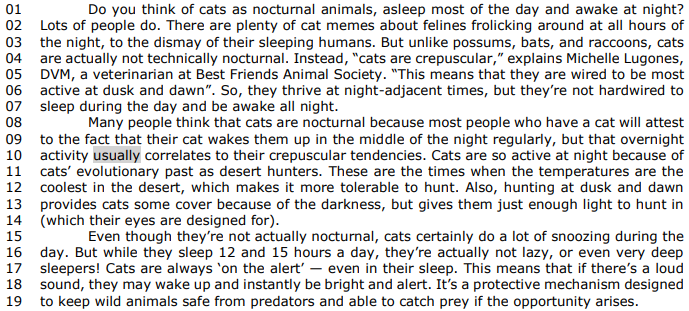Questões de Concurso
Sobre pronúncia e som | pronunciation and sound em inglês
Foram encontradas 163 questões
Julgue o item subsequente.
Intonation, the rise and fall of pitch in speech, plays a
crucial role in conveying the speaker's attitude, mood, and
intended meaning in American English. Different
intonation patterns can distinguish between statements,
questions, and exclamations, contributing significantly to
effective communication.
Julgue o item subsequente.
Word stress in American English is a crucial aspect of
pronunciation. It involves emphasizing a specific syllable
within a word, and its correct application plays a
significant role in conveying meaning and maintaining
intelligibility.
Julgue o item subsequente.
Sentence stress, also known as prosody, is essential in
American English for conveying the intended meaning of
a sentence. It involves emphasizing certain words or
syllables to communicate nuances such as importance,
contrast, or emotion. Mastering sentence stress
contributes to effective communication in spoken English.


Column 1 1. /s/ 2. /z/ 3. /ɪz/
Column 2
( ) Calendars ( ) Bosses. ( ) Tasks
The correct order of filling the parentheses, from top to bottom, is:
“Mistakes are often divided into errors and slips. Errors happen when learners try to say something that is beyond their current level of language processing. Usually, learners cannot correct errors themselves because they don’t understand what is wrong. Errors play a necessary and important part in language learning. Slips are the result of tiredness, worry or other temporary emotions or circumstances. These kinds of mistakes can be corrected by learners once they realize they have made them.”
(SPRATT; PULLVERNESS; WILLIAMS, 2005, p. 44)
Judge the items below as (T) True or (F) False.
1. There are two main reasons why learners make errors. The first reason is influence from the learner’s first language (L1) on the second language. This is called interference or transfer. Learners may use sound patterns, lexis or grammatical structures from their own language in English. The second reason is because they are unconsciously working out or organizing language, but this process is not yet complete. This kind of error is called a developmental error.
2. Errors in which learners wrongly apply a rule for one item of the language to another item are known as overgeneralization, and as a second language learners’ language ability increases, these kinds of errors also reduce.
3. Errors are part of learner’s interlanguage, which develops and progresses as they learn more. Experts think that interlanguage is an essential and unavoidable stage in language learning. In other words, interlanguage and errors are necessary to language learning.
4. Errors are a natural part of learning. They usually show that learners are learning and that their internal mental processes are working on experimenting with language.
5. Sometimes errors do not disappear, but get fossilized. These fossilized errors may be the result of lack of exposure to the second language and/or of a learner’s lack of motivation to improve their level of accuracy.
Choose the CORRECT sequence.
Considering language and background to language learning and teaching, match the topic to its definition.
( 1 ) Grammar ( 2 ) Lexis ( 3 ) Phonology ( 4 ) Function
( ) is the study of the sound features used in a language to communicate meaning. ( ) is a reason why we communicate. ( ) describes how we combine, organize and change words and parts of words to make meaning. ( ) is individual words or sets of words that have a specific meaning.
Choose the item with the CORRECT sequence.
Peachey, N. (2021), disponível em: https://www.teachingenglish.org.uk/article/content-based-instruction, accessed on 15h December 2022.
According to Peachey, judge the items as (T) True or (F) False concerning CBI ADVANTAGES.
I. It can make learning a language more interesting and motivating. Students can use the language to fulfill a real purpose, which can make them both more independent and confident.
II. Taking information from different sources, re-evaluating and restructuring that information can help students to develop very valuable thinking skills that can then be transferred to other subjects. So students can also develop a much wider knowledge of the world through CBI, which can feed back into improving and supporting their general educational needs.
III. CBI is very popular among EAP (English for Academic Purposes) teachers as it helps students to develop valuable study skills such as note taking, summarizing and extracting key information from texts.
IV. The inclusion of a group work element within the framework given can also help students to develop their collaborative skills, which can have great social value. V. Particularly in monolingual classes, the overuse of the students' native language during parts of the lesson can be a problem. Because the lesson isn't explicitly focused on language practice, students find it much easier and quicker to use their mother tongue.
VI. It can be hard to find information sources and texts that lower levels can understand. Also the sharing of information in the target language may cause great difficulties.
Choose the CORRECT sequence.
Choose the CORRECT item that points the basic premises of this approach.
According to Rodinadze, S., & Zarbazoia, K., 2012, judge the items below as (T) True or (F) False regarding the ADVANTAGES of information technology in teaching the English language.
I. Information technology helps students as well as teachers in studying the course material easily because of fast access. Studying the subjects with the help of online libraries and dictionaries has made grasping and increasing knowledge easy for the students.
II. Information technology may facilitate learning or serve as the actual educational structure allowing learning to occur. It benefits both traditional education institutions and online educational models in fundamental ways. For example, multimedia presentations, knowledge-management softwares, apps, mobile devices such as tablets, personal digital assistants (PDAs), lap tops, video conferencing, cloud computing, and collaborative document editing are notable information technology services benefiting education that can provide teachers with an endless choice to create more exciting and interactive lessons.
III. Students and educators utilizing cloud computing to store their homework can also modify the documents access settings to allow multiple editors and contributors to participate in an assignment. This empowers educators to design work assignments for teams of students working together and, in so doing, cultivate a teamwork ethos preparing them for the workplace. Now information technology has made it easy to study as well as teach in groups or in clusters. At the English lessons with online resources they can be united together to do the desired task.
IV. Teachers can enter grades and assignment updates online, rather than in a paper grade-book. Libraries with a digital database in place of a traditional card catalog make their resources available for students to search anywhere with an Internet connection. Staff members can find and send transcript information and other records quickly by accessing a digital filing system, saving time and paper.
V. Information and communication technology opens the doors for better distance learning programs, allowing those in disadvantaged areas to have access to the same education as the privileged. Because this technology makes information accessible from nearly any location with a mobile device or laptop, courses can be more flexible; meaning those with full schedules who may not have the time or opportunity to further their education can choose to enroll in courses online and complete assignments on their own time.
VI. Interactive audio and video allow real time communication using phones and computers at the English lessons. Voice over Internet Protocol enables a person's voice to be transmitted through an Internet connection. Voice and multimedia presentations can also be delivered to a dispersed class with questions and answers taking place in real time.
Choose the CORRECT sequence.
According to Fiorito (2005), what is INCORRECT to say about English for Specific Purposes (ESP)?
I.The knight is waiting for you! II.The night will still be long.
The words in bold are:
